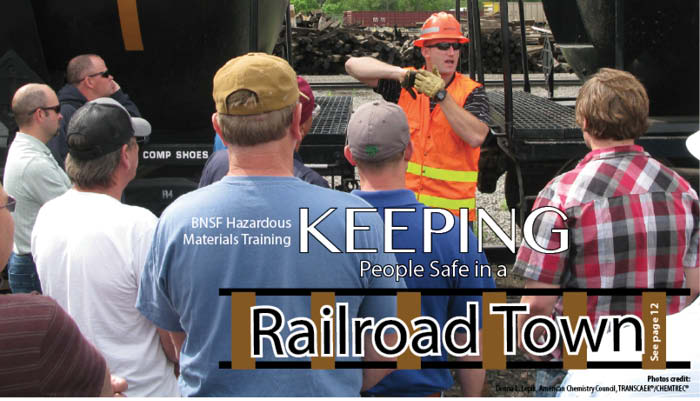It doesn’t take long for visitors in the Red River Valley to notice the area’s high prevalence of trains. For those that live here, however, the rumbling line of rail cars quickly becomes a way of life. Commuters traveling from one side of the city to the other instinctively incorporate potential train delays into their daily routines. Routes that utilize an underpass are frequently taken to avoid railroad tracks altogether, even if such paths add considerable time to a trip. For many, trains are simply nuisances that must be dealt with. For area first responders, however, trains are viewed as something altogether different.
Burlington Northern Santa Fe (BNSF) is one of the nation’s premier rail transportation companies in North America. The company operates 32,500 route miles in 28 states and Canada. Over BNSF 1,600 trains travel through the country each day, 70 of which can be found right here in the Valley. An additional 60 trains representing other companies also roll through the city, meaning F/M residents deal with upwards of 130 trains per day.
In 2013, BNSF transported 1.8 million carloads of industrial products. These cars carried enough crude oil from western North Dakota to fill the tanks of over 656,000 average sized vehicles with gas for a day. It is estimated that anywhere from 5-10 trains carry oil through the heart of the Valley on any given day. For some residents, the black cylindrical cars are indicative of little more than a very long train. For others, however, they are disasters waiting to happen.
Ask residents of Casselton, North Dakota how they feel about oil cars and they will likely tell you stories of black smoke billowing from the December 2013 train derailment and subsequent explosion. The crash spilled 400,000 gallons of crude oil and forced the evacuation of over half of the town. Although the Casselton crash did not result in any injuries or loss of life, the prevailing question during that event was whether or not the area was ready to respond to a catastrophe involving rail transportation.
BNSF understands the potential for rail disaster and is trying to help remedy the lack of preparedness. Even though the company has designated personnel trained to assist in derailment types of events, they are often located many miles away from rural areas like Casselton. First responders in that case were local firefighters and volunteer emergency personnel. Most had not been trained in train incidents involving hazardous materials. BNSF wants to change that. In 2014, the company provided hazardous materials training to over 1,000 first responders in the state of Minnesota, including nine from the Dilworth/Moorhead area. Over that time period, the company trained 3,500 to 4,000 total responders around the country.
According to BNSF, the training sessions utilize a combination of hands-on instruction involving special training tank cars, emergency planning assistance, and community drills and exercises. Instructors use pieces of equipment from actual trains to provide attendees with a realistic training experience. For example, the instructors use authentic valves and hatches to teach the first responders how to contain leaks by opening and closing them. They are also taught how to accurately measure conditions such as pressure and temperature so they can make a proper diagnosis of the situation.
Although BNSF prides itself on its safety record, it also understands that precarious nature of rail transportation. “BNSF is making record capital investments in the railroad to improve the reliability of our physical infrastructure, which helps to further improve the safety of our operations,” explained BNSF Director of Public Affairs Amy McBeth. “This year’s plan to spend $6 billion across our network, much of it focused on our northern corridor, also will allow us to better serve all of our customers as we see strong growth across commodities in the region.”
While there are many hazardous materials that are routinely transported via rail, oil is the most prevalent. According to the National Transportation Safety Board, an estimated nine million barrels of crude oil are moving over rail lines in North America at any given moment. In the Red River Valley, watching oil cars move through the city is a daily occurrence. Since shipping oil via rail is considered five times faster than shipping via pipeline, the site of those cars is going to continue.
According to BNSF, over 99% of their hazmat shipments were delivered without incident. It is that 1%, however, that concerns industry experts and residents alike. Will there be another incident like the Casselton derailment? What would happen if cars were to derail inside Fargo or Moorhead? How would we respond? What would we do? BNSF is doing everything it can to not only minimize the chance of that happening, but to also train area responders in case it does. Although the likelihood of a catastrophic event is minimal, it only takes one.


